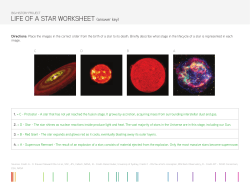
Audience Theory Booklet
CRITICAL PERSPECTIVES IN MEDIA Audience Key Concepts Essential Theory / Theorists for Audience: Barthes, Hall, Mulvey, Dyer Audience Barthes was an influential theorist who explored the way in which texts make meaning. Building on linguistics, he considered that all cultural forms; including media, are essentially made up of a system of signs. Barthes identifies two interrelated theoretical perspectives: 1. 2. Semiotics - the study of individual signs Structuralism - the study of the relationships between those signs He argues that the organisation of these relationships encodes particular ideologies. The Theory The Active Audience - Barthes considered texts to be open to many possible interpretations (readings) from many different perspectives. To consider different possible readings, he pulled texts apart, to look at the pieces (semiotics) and how they fit together (structuralism). Rather than having a meaning determined by the producer, or one which is somehow ‘in’ the text, Barthes considered the meaning of the finished text – a book, song, film or advertisement – is to be created by the audience, therefore a text always remains open. Myth and Ideology - The term myth has two everyday meanings: 1. 2. A traditional narrative which explains symbolically the origins of the world and natural phenomenon and is passed down through generations, for example, creation myths explain how the world began Something which is untrue although it is believed to be true such as ‘it is a myth that students can leave after fifteen minutes if their teacher doesn’t turn up’. Influences on Barthes Ferdinand de Saussure (Linguistics) Vladimir Propp (Russian Formalism) Drawing on Marxist theory, for Barthes myth works at the level of ideology. Representations created in the mass media, through signs (semiotics) and the structures between them (structuralism), naturalise a particular view of the world. These representations may ‘mask’ reality. The construction of myths in representations and narratives therefore determines the text’s ideological perspective. Audience Narrative codes - Barthes suggested meaning is made in fiction texts by the use of these five codes: 1 The enigma code a.k.a. the hermeneutic code Narratives set up puzzles to be solved; these enigmas delay the end of the narrative & maintain audience’s interest & anticipation. The answers to the puzzles are satisfyingly resolved later in the text For example, the origin of Harry Potter’s lightening scar is not made clear until later in the series. 2 The events and actions code a.k.a. the proairetic code Relates to progression in the narrative and involves codes of behaviour or actions that lead us to expect consequences. Barthes asserts that each action could be named giving a series of titles to the text. These action codes often made very explicit on the DVD – the chapter titles are generally based on events or significant actions. 3 The symbolic code 4 The semic code 5 The cultural code The process of representing an object, idea or feeling by something else (a visual metaphor). Often used to symbolise opposition which exists in the narrative (ref Levi-Strauss) Refers to the use of connotation to give the audience an insight into characters, objects or settings that we learn to read through our understanding of narratives. Media Language Concerns the culturally specific knowledge from outside the text which is used to make meaning in a text. Media Language & Audience For example, a fence between two characters may symbolise their emotional distance / conflict. For example the colour red is often used to suggest danger or passion; therefore a red dress worn by a female character is likely to suggest her sexuality and/or danger. For example Big Ben at the beginning of the news references the heart of political power in the UK. Glossary of Terminology you should use to analyse texts using Barthes ideas: Structuralism: Approach to media analysis which borrows its principles from linguistics (the study of language). Structuralism considers the relationships (structures) between signs to be more important than what a sign may mean on its own. Myth: Artificial representations and invalid beliefs about society that circulate in cultural products, such as the mass media. Paradigm: A group of similar signs from which a selection is made to make a text (i.e. a selection may be made between a paradigm of colours, a paradigm of fonts, and a paradigm of sizes to produce red point 12 typography in Times New Roman). o Syntagm: The combination of signs selected from different paradigms. In the example above, red point 12 typography in Times New Roman is a syntagm. Semiotics: The study of signs o Sign: A unit that makes meaning (Media Language) Icon (Denotation through close resemblance): A sign which visually corresponds to that which it represents. The thing looks like the thing it represents Index (Denotation through cause & effect) A sign which refers in some way to that which it represents. Smoke is an index of fire. An echo is an index of space. Footprints are an index of a person walking ahead. Symbol (Connotation): A sign which is used to represent something to which it bears no logical relationship. For example, there is no reason why green should symbolise jealousy. A rainbow may be symbolic of hope. Audience Stuart Hall is a cultural theorist who tries to explain how society interacts and how individuals in society have different interpretations and responses to media texts. He tried to understand a very simple question; ‘Why do some people like one media text and dislike another? ’ Furthermore he tried to understand the ideological underpinning of media texts & media audiences and he moved media theory away from a model, which assumed that the audience was a ‘mass audience’ which responded en-mass and interpreted a text in the same way. His ideas are part of ‘Reception Theory’. Reception theory states that the way in which an audience have individual interpretation of a media text and that reading is a two stage process. 1. The producer encodes ideology into a text and wishes it to be read in a particular way. 2. The audience then decode the text, but they also bring their own ideology to the text. Meaning is made where ideologies meet. This means that a media text can be read in three possible ways: The factors which cause people to read media differently, he explained by saying there are four areas which have an impact on our interpretation. 1 Preferred Producer’s Ideology (Encodes) •Audience accepts the values / ideas encoded in the text 2 Negotiated 3 Oppositional •Audience accepts some of the values / ideas encoded in the text (conditionally) •The audience rejects the values / ideas encoded in the text Audience’s Ideology (Decodes) Audience What factors affect your reading? Demographic Who you are Psychographic Values, Opinions and Beliefs Situated Culture How & where you consume the text Cultural Experiences Your cultural understanding and experiences Reception Theory Essay (500-750 words), 3 Parts: Ideology & Meta-narrative Explain the ideology (brand values) of your star / band as they are communicated through their meta-narrative. A preferred reading Who are the audience(s) (age, gender, socio economic group) who would be ideologically attracted to this star/band and explain what ideologies they would find attractive and why you think this is. An oppositional reading Who are the audience(s) (age, gender, socio economic group) who would ideologically reject this star/band and explain what ideologies they would find unattractive and why you think this is. Glossary Ideology: values, attitudes, beliefs, opinions. Use specific examples of from the media texts your have researched Analyse how those features make meaning Where possible use media specific terminology Audience Frequently quoted but often misunderstood, the work of Laura Mulvey on ‘the Gaze’ is at the heart of feminist film theory, and has been hugely influential since the mid-1970s. Essentials Her most famous work to date is her seminal essay ‘Visual Pleasure and Narrative Cinema’, written in 1973 and first published in 1975 in the British film theory journal Screen. At a simple level, she argued that the typical audience member is assumed to be male. Furthermore, the typical audience member becomes aligned with the film’s male protagonist. According to the theory, women in film are simply objects for ‘the gaze’ of the protagonist & male audience. Influences Mulvey’s essay ‘Visual Pleasure and Narrative Cinema’ borrowed from popular psychoanalytical frameworks of the time, specifically Sigmund Freud’s concept of scopophilia and Jacques Lacan’s reinterpretation of this by his explanation of the child’s ‘mirror stage’. The Psychoanalytical theory FREUD AND SCOPOPHILIA; Put simply, scopophilia is the pleasure of watching; specifically the mature adult’s desire to see things that are culturally forbidden or taboo. JAQUES LACAN AND THE MIRROR STAGE; In essence, the Mirror Stage, according to Lacan, refers to the moment in early childhood when the child perceives itself as an independent being. At some stage, generally between six and eighteen months, the child looks in the mirror and recognises itself. It feels a sense of jubilation at its own independent existence, and this feeds into its ego and a sense of narcissistic pleasure. When children first perceive themselves as independent of their mother by way Hitchcock’s Psycho (1960) has been widely associated with Freud’s theories. Audience of their mirror reflection, it is at a stage of frustration in their personal development; as their physical desires are greater than their physiological ability. They then consider their mirror reflection to be more able, more perfect, and more complete than they currently feel. Mulvey believes that this stage leads into the process of film viewing in adulthood, as the mirror is replaced by the screen. The typical audience member gains a sense of narcissistic pleasure from identifying with the film’s protagonist, and following fascination with their filmic counterpart. LAURA MULVEY AND THE GAZE Applying these ideas to Hollywood film viewing, Mulvey suggested that women in film are represented as ‘objects’, images with visual and erotic impact, which she termed their ‘to-be-looked-at-ness’. Classical Hollywood films positioned the audience as male, and through identification with the male protagonist (Lacan) gave him an active role in viewing the female subject and gaining pleasure from doing so (Freud). This look, from audience to actress, is termed ‘the look’ or ‘the gaze’. According to Mulvey the look could be ‘voyeuristic’ (women are viewed as virtuous and beautiful) or ‘fetishistic’ (women are viewed as excessively sexual beings). Glossary of Terms Scopophilia: The pleasure of watching what shouldn’t be seen (taboo images). Mirror Stage: Lacan’s term used to describe the stage at which a child realises they are a person independent of their mother. Narcissism: Excessive or erotic interest in the self. Voyeuristic Gaze: A gaze which objectifies the recipient of the gaze in a non-sexual manner, rather through admiration. Fetishistic Gaze: A gaze which objectifies the recipient of the gaze in a sexual manner. To-be-looked-at-ness: The way in which a character is constructed, using media language (through the framing of shots and position of the camera) to be objectified by another character or the audience’s gaze. Objectified: to be viewed as an object rather than a person; often women in films/music videos are seen as objects of male desire. Audience Richard Dyer Star Theory Richard Dyer is a British media theorist, who discussed a star’s special place in the audiences’ lives. He (similarly to Hall) suggests that a star’s meta-narrative impacts on the consumption by the audience. He argued that the star image is manufactured and artificial and that individual stars have their own unique selling point (brand values) in order to grab and hold our attention – for example – Justin Bieber’s hair, JLS’ colour codes... The Paradox of the Star Dyer’s central idea was that the star image could be discussed using two key paradoxes. ‘What on earth is a paradox,’ you may ask – well, it’s a statement that contradicts itself. Dyer suggested that a star image simultaneously has two contradictory representations. He said... ‘...a star is both ordinary & extraordinary.’ Dyer suggested that a star must be represented simultaneously as, just like us (the audience/regular people), but also at the same time possess something we do not have and something that makes them special, different, extraordinary... This might mean they are more talented, gifted, confident, passionate, artistic, sensitive, carefree or sexy, but also they are allowed to be rebellious, anti-social, or angry maybe. They are idealised version of humanity...idols. ‘...a star is both present & absent.’ Dyer also thought that the audience struggles with another paradox; and that is that the star is simultaneously present in our lives, be this in our social groups chat, our style, our identity, and our consumption habits.. However they are also absent, something that we perceive as out of reach, on a pedestal, and not actually there. o Note: This links in really nicely with a postmodern theory called hyper-reality that we will look at next term. Dyer argued that as an audience we strive to complete the star image through consuming their products, shows, merchandise etc. We strive to complete the image by engaging with the star’s meta-narrative and, if possible, seek the ultimate satisfaction, seeing them live! The problem of course is that the meta-narrative shifts and changes and we are constantly striving to complete the image and constantly frustrated in our attempts to do so.
© Copyright 2025





















